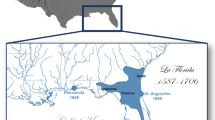Abstract
The techniques used by the Sanio-Hiowe of Papua New Guinea to produce edible starch from the sago palm (Metroxylon sp.) are described. Input-output analysis demonstrates that this is a highly productive subsistence technology; nevertheless, the Sanio-Hiowe economy is characterized by an absence of intensification. This is ascribed to functional consequences of dependence on hunting and gathering in the interior. In coastal and riverine habitats, other societies using sago supplemented by fishing or horticulture can more fully exploit the potential of sago as a basis for economic intensification and a more sedentary life.
Similar content being viewed by others
References
Barrau, J. (1959). The sago palms and other food plants of marsh dwellers in the South Pacific Islands.Econ. Bot. 13: 151–162.
Boserup, E. (1965).The Conditions of Agricultural Growth, Aldine, Chicago.
Buck, J. L. (1930).Chinese Farm Economy, University of Chicago Press, Chicago.
Carneiro, R. L. (1957). Subsistence and social structure. Unpublished doctoral dissertation, University of Michigan, Ann Arbor.
Carneiro, R. L. (1968). The transition from hunting to horticulture in the Amazon Basin.Proc. VIIIth Congr. Anthropol. Ethnol. Sci. (Tokyo and Kyoto) 3: 244–248.
Conklin, H. C. (1957).Hanunoo Agriculture, Food and Agricultural Organization of the United Nations, Rome.
Damm, H. (1957). Methoden des Feldbaues in Ozeanien. InAgrarethnographie: Veroffentlichunger des Instituts für Deutsche Volkskunde, Vol. 13, Akademie der Wissenschaften, Berlin, pp. 149–165.
Dye, W., Townsend, P., and Townsend, W. (1968). The Sepik Hill languages.Oceania 39: 146–155.
Edwards, E. T. (1961). The natural stands of sago palms,Metroxylon spp., in the Sepik River area of New Guinea and their possible use as a source of commercial starch. Report submitted to the Board of Directors of Geo. Fielder & Co., Ltd., Sydney.
Firth, R. W. (1950). Economics and ritual in sago extraction.Mankind 4: 131–142.
Fortune, R. F. (1932).Sorcerers of Dobu, E. P. Dutton, New York.
Haberland, E. (1966). Sago and “Austronesier,” Bemerkungen zur kulturhistorischen Methode.Mitteil. Kulturkunde 1: 81–101.
Harding, T. G. (1967).Voyagers of the Vitiaz Strait—A Study of a New Guinea Trade System, University of Washington Press, Seattle.
Harris, M. (1959). The economy has no surplus?Am. Anthropologist 61: 185–199.
Harris, M. (1971).Culture, Man, and Nature: An Introduction to General Anthropology, Crowell, New York.
Haswell, M. R. (1953). Economics of agriculture in a savannah village.Colonial Res. Stud. No. 8.
Held, G. J. (1957).The Papuas of Waropen, M. Nijhoff, the Hague.
Hogbin, H. I. (1939). Tillage and collection: A New Guinea economy.Oceania 9: 127–151, 286–325.
Holling, C. S., and Goldberg, M. A. (1971). Ecology and planning.J. Am. Inst. Planners 37: 221–230.
Lea, D. A. M. (1964). Abelam land and sustenance. Unpublished doctoral dissertation, Australian National University, Canberra.
Lee, R. B. (1968). What hunters do for a living, or, how to make out on scarce resources. In Lee, R. B., and DeVore, I. (eds.),Man the Hunter, Aldine, Chicago, pp. 30–48.
Lewis, R., and Lewis, S. (1970). Tentative phonemic statement: Sanio-Hiowe. Unpublished manuscript, Summer Institute of Linguistics.
Lloyd, R. L. (1964). Starches in food processing. In Joslyn, M. A., and Herd, J. L. (eds.),Food Processing Operations, Vol. 3, Avi, Westport, Conn.
Maher, R. F. (1961).New Men of Papua, University of Wisconsin Press, Madison.
Malinowski, B. (1922).Argonauts of the Western Pacific, George Routledge, London.
McArthur, M. (1960). Food consumption and dietary levels of groups of Aborigines living on naturally occurring foods. In Mountford, C. P. (ed.),Records of the American-Australian Scientific Expedition to Arnhem Land, Vol. 2, Melbourne University Press, Melbourne, pp. 90–135.
McCarthy, F. D., and McArthur, M. (1960). The food quest and the time factor in Aboriginal economic life. In Mountford, C. P. (ed.),Records of the American-Australian Scientific Expedition to Arnhem Land, Vol. 2, Melbourne University Press, Melbourne.
Morley, S. G. (1946).The Ancient Maya, Stanford University Press, Stanford, Calif.
Morris, H. S. (1953). Report on a Melanau sago producing community in Sarawak.Colonial Res. Stud. No. 9.
Oosterwal, G. (1961).People of the Tor, Van Gorcum, Assen.
Peters, F. E. (1957). Chemical composition of South Pacific foods — An annotated bibliography.South Pacific Commission Technical Paper, No. 100.
Rappaport, R. A. (1968).Pigs for the Ancestors, Yale University Press, New Haven.
Sahlins, M. (1972).Stone Age Economics, Aldine, Chicago.
Schlesier, E. (1961). Zum Problem einer Sago-verwertenden Kulturschicht auf Neuguinea.Z. Ethnol. 86: 224–233.
Schlesier, E. (1965). Sagogewinnung auf Normanby Island, Südost Neuguinea.Baessler-Arch. 13: 1–39.
Seligman, C. G. (1910).The Melanesians of British New Guinea, Cambridge University Press, Cambridge.
Sprecher Von Bernegg, A. (1929).Tropische und subtropische Weltwirtschaftsplantzen, Vol. 1, F. Enke, Stuttgart.
Suarez, M. M. (1968).Los Warao — Indigenas del Delta del Orinoco, Instituto Venezolano de Investigaciones Cientificas, Caracas.
Townsend, P. K. (1971). New Guinea sago gatherers: A study of demography in relation to subsistence.Ecol. Food Nutr. 1: 19–24.
Townsend, P. K., Liao, S.-C., and Konlande, J. E. (1973). Nutritive contributions of sago ash used as a native salt in Papua New Guinea.Ecol. Food Nutr. 2: 91–97.
Townsend, W. H. (1969). Stone and steel tool use in a New Guinea society.Ethnology 8: 199–205.
van der Leeden, A. C. (1956).Hoofdtrekken der sociale Struktuur in het Westelijke Binnenland van Sarmi, Eduard Ijdo N. V., Leiden.
Wagley, C. (1953).Amazon Town, Macmillan, New York.
Wallace, A. R. (1869).The Malay Archipelago, Harper, New York.
Whiting, J. W. M., and Reed, S. W. (1939). Kwoma culture.Oceania 9: 170–216.
Author information
Authors and Affiliations
Additional information
This field research among the Sanio-Hiowe of Yareno hamlet was carried out from March 1966 to August 1967 with the assistance of W. Townsend and the support of a National Science Foundation dissertation research grant and a United States Public Health Service Fellowship. In earlier publicationsHiowe was spelledHeve. I have altered the spelling of Sanio words to conform to the phonemic analysis of Lewis and Lewis (1970).
Rights and permissions
About this article
Cite this article
Townsend, P.K. Sago production in a New Guinea economy. Hum Ecol 2, 217–236 (1974). https://doi.org/10.1007/BF01531422
Received:
Revised:
Issue Date:
DOI: https://doi.org/10.1007/BF01531422




